신생아의 손과 발의 발육(신생아의 손과 발의 발달), Development of hands and feet in newborn infants
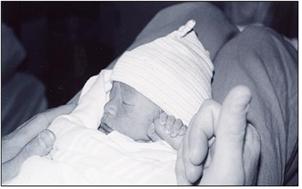
사진 2-26. 갓 태어난 신생아가 자기 손으로 아빠의 손가락을 꼬옥 잡고 있다. 아빠가 아기를 무릎 위에 올려놓고 둘이서 신체적 접촉 사랑을 만끽하고 있다. 아기의 한 쪽 손의 크기가 아빠의 새끼손가락 한 마디만큼 큰 것을 볼 수 있다.
Copyright ⓒ 2011 John Sangwon Lee, MD., FAAP

사진 2-27. 갓 태어난 신생아가 자기의 손을 아빠의 손바닥에 올려놓고, 누구 손이 큰지 비교하면서 둘이서 신체적 접촉 사랑을 만끽하고 있다.
Copyright ⓒ 2011 John Sangwon Lee, MD., FAAP
- 신생아들의 손과 발은 대개 불수의적으로 움직이는 것이 보통이다.
- 그러나 다음과 같은 경우, 수의적으로 움직이는 면도 있는 것 같다.
- 피 검사를 하기 위해 신생아의 한쪽 발에서 피를 뽑을 때가 있다.
- 피를 뽑는 사람이 한쪽 손으로 신생아의 한쪽 발을 붙들고 피를 뽑을 때 그 신생아는 피를 뽑지 않는 쪽의 발로 피 뽑는 쪽 발을 잡은 임상 검사자의 손을 차는 것을 볼 수 있다.
- 이런 실 예를 보면, 신생아도 수의적으로 손발을 어느 정도로 움직일 수 있는 것 같다.
- 건강한 모든 신생아에게 파악 반사가 있다.
- 파악 반사는 자연 원시 반사이다.
- 신생아의 손바닥에 엄마나 아빠의 손가락을 갖다 대면 신생아는 그 손을 꼭 붙잡고 쉽게 놓지 않는다. 이런 현상은 불수의적으로 생기는 정상적인 원시 반사이다.
- “파악 반사(Grasp reflex)”는 신생아가 엄마의 품에서 절대로 떨어지지 않고 매달리려는 반사인 것 같다.
- 엄마에게 “나는 엄마의 품에서 떨어져 나가지 않겠다. 알리는 몸짓 말이라고 생각한다.
- 파악 반사는 태어난 이후 바로 나타나고 생후 3∼4개월경에 자연히 없어진다.
- 생후 3∼4 개월 전후로 영아들(생후 29일부터 첫돌까지)은 손을 어느 정도 수의적으로 움직일 수 있다.
- 태어난 이후부터 신생아 발에 “걷는 반사”가 나타난다.
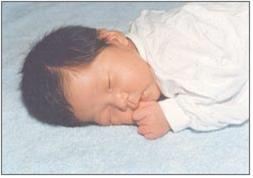
사진 2-28. 신생아가 손을 입에 물고 잔다.
Copyright ⓒ 2011 John Sangwon Lee, MD., FAAP
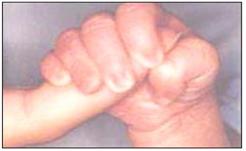
사진 2-29. 갓 태어난 아기가 엄마의 손가락을 잡고 있다.
이런 현상은 파악 반사로 생긴다. 아름다운 신생아 손톱을 볼 수 있다. Copyright ⓒ 2011 John Sangwon Lee, MD., FAAP

사진 2-30. 2주 된 신생아가 엄마의 손가락을 잡고 있다.
이것도 파악 반사 현상이다. 파악반사는 원시반사의 일종이다. Copyright ⓒ 2011 John Sangwon Lee, MD., FAAP
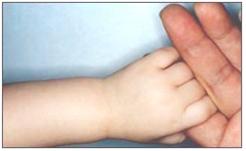
사진 2-31. 신생아가 손으로 엄마의 손을 잡고 있다. 아기 손에 몽고 반점이 있다.
Copyright ⓒ 2011 John Sangwon Lee, MD., FAAP
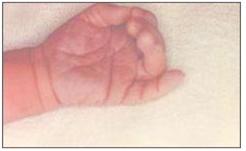
사진 2-32. 갓난아기의 예쁜 손
Copyright ⓒ 2011 John Sangwon Lee, MD., FAAP
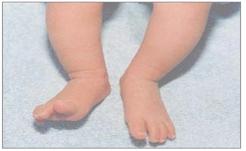
사진 2-33. 신생아의 정상 아랫다리와 발․
생리적 0형 다리가 보인다. 점점 크면서 2세 전 더 이상 O형 다리를 보지 않는 것이 보통이다.
Copyright ⓒ 2011 John Sangwon Lee, MD., FAAP
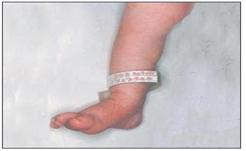
사진 2-34. 신생아의 정상 아랫다리와 발 신생아실에서 자기의 성명 발목밴드를 차고 있다.
Copyright ⓒ 2011 John Sangwon Lee, MD., FAAP
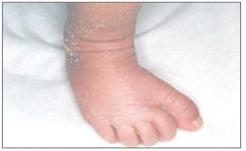
사진 2-35. 신생아의 정상 발
발의 피부의 표피가 살짝 조금 벗겨지는 것은 대개 정상이다.
신생아의 발에 생리적 내반이 생겨 있다.
Copyright ⓒ 2011 John Sangwon Lee, MD., FAAP
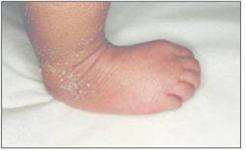
사진 2-36. 신생아의 정상 발
신생아의 발에 “생리적 내반”이 생겨 있다. 발의 피부가 살짝 조금 벗겨지는 것은 대개 정상이다. 이런 생리적 내반 현상은 자연히 정상으로 돌아간다.
Copyright ⓒ 2011 John Sangwon Lee, MD., FAAP

사진 2-37. 신생아의 정상 발
대부분의 신생아들의 발바닥은 정상적으로 편평하다. 신생아들의 발바닥에 뚜렷한 발바닥 아치가 정상적으로 생겨 있지 않다. 이런 발바닥을 “생리적 편평족”이라 한다.
Copyright ⓒ 2011 John Sangwon Lee, MD., FAAP

사진 2-38. 신생아의 정상 발
대부분의 신생아들의 발바닥은 정상적으로 편평하다. 이런 발바닥을 “생리적 편평족”이라 한다. 자연 치료된다.
Copyright ⓒ 2011 John Sangwon Lee, MD., FAAP
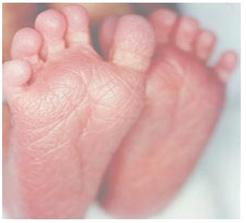
사진 2-39.신생아의 정상 두 발. 엄지발가락과 둘째발가락 사이가 정상적으로 더 벌어져있다. 이것도
정상적이다. Copyright ⓒ 2011 John Sangwon Lee, MD., FAAP
Development of hands and feet in newborn infants 신생아의 손과 발의 발육(신생아의 손과 발의 발달)

Photo 2-26. A newborn baby is holding her dad’s finger with her own hand. Dad puts her baby on his lap and the two are enjoying the love of physical contact. You can see that the size of one hand of the baby is as large as a measure of the father’s little finger. Copyright ⓒ 2011 John Sangwon Lee, MD., FAAP

Photo 2-27. Her newborn baby puts her own hand on her dad’s palm, comparing which of her hand is larger, enjoying the love of physical contact as the two. Copyright ⓒ 2011 John Sangwon Lee, MD., FAAP
Newborns’ hands and feet usually move involuntarily.
However, there seems to be some voluntary movement in the following cases.
Sometimes blood is drawn from one foot of a newborn to do a blood test. It can be seen that when a blood drawer holds one foot of the newborn with one hand and draws blood, the newborn kicks the clinical examiner’s hand holding the blood-draining foot with the non-bleeding foot.
Looking at this example, it seems that even a newborn baby can voluntarily move her limbs and feet to some extent. All healthy newborns have a grasping reflex.
Hold reflex is a natural primitive reflex. If you place her mother’s or dad’s finger on the newborn’s palm, the newborn will hold the hand tight and do not release it easily.
This phenomenon is a normal primitive reflex that occurs involuntarily.
The “Grasp reflex” seems to be the reflex that the newborn tries to hang from her mother’s arms without ever falling. To her mother, “I will not fall out of my mother’s arms. I think it’s an informative gesture.
The grasping reflex appears immediately after birth and disappears naturally around 3-4 months of age. Around 3-4 months of age, infants (from the 29th to the first birthday) can move their hands voluntarily to some extent.
A “walking reflex” appears on the newborn’s feet from birth.

Photo 2-28. A newborn baby sleeps with her hand in her mouth. Copyright ⓒ 2011 John Sangwon Lee, MD., FAAP

Photo 2-29. The newborn baby is holding her mom’s finger. This phenomenon arises from grasping reflexes. You can see beautiful newborn nails. Copyright ⓒ 2011 John Sangwon Lee, MD., FAAP

Photo 2-30. A 2-week old newborn baby is holding her mom’s finger. This is also a grasping reflex phenomenon. The grasping reflex is a kind of primitive reflection. Copyright ⓒ 2011 John Sangwon Lee, MD., FAAP

Photo 2-31. A newborn baby is holding her mom’s hand with her hand. Her baby has Mongolian spots on her hands. Copyright ⓒ 2011 John Sangwon Lee, MD., FAAP

Photo 2-32. Baby’s pretty hands. Copyright ⓒ 2011 John Sangwon Lee, MD., FAAP

Photo 2-33. Newborn’s normal lower legs and feet․ The physiological type O leg is visible. It’s common to see more and more O-shaped legs before the age of two. Copyright ⓒ 2011 John Sangwon Lee, MD., FAAP

Photo 2-34. The newborn’s normal lower legs and feet are wearing an ankle band that makes her statement in her newborn room. Copyright ⓒ 2011 John Sangwon Lee, MD., FAAP

Photo 2-35. Newborn’s normal feet It is usually normal for a slight peeling of the epidermis of the skin of the foot. There is a physiological varus on the newborn’s feet. Copyright ⓒ 2011 John Sangwon Lee, MD., FAAP

Photo 2-36. Newborn’s normal feet. There is a “physiological varus” on the newborn’s feet. It is usually normal for the skin of the foot to peel off slightly. These physiological varus phenomena naturally return to normal. Copyright ⓒ 2011 John Sangwon Lee, MD., FAAP

Photo 2-37. Newborn’s normal feet. The soles of most newborns are normally flat. Newborns soles do not have distinct plantar arches normally. These soles are called “physiological flat foot”. Copyright ⓒ 2011 John Sangwon Lee, MD., FAAP

Photo 2-38. Newborn’s normal feet. The soles of most newborns are normally flat. These soles are called “physiological flat foot”. It is treated naturally. Copyright ⓒ 2011 John Sangwon Lee, MD., FAAP

Picture 2-39. Normal two feet of a newborn baby. There is a normal gap between the big toe and the second toe. This is also normal. Copyright ⓒ 2011 John Sangwon Lee, MD., FAAP
출처 및 참조 문헌
- NelsonTextbook of Pediatrics 22ND Ed
- The Harriet Lane Handbook 22ND Ed
- Growth and development of the children
- Red Book 32nd Ed 2021-2024
- Neonatal Resuscitation, American Academy Pediatrics
- www.drleepediatrics.com 제1권 소아청소년 응급 의료
- www.drleepediatrics.com 제2권 소아청소년 예방
- www.drleepediatrics.com 제3권 소아청소년 성장 발육 육아
- www.drleepediatrics.com 제4권 모유,모유수유, 이유
- www.drleepediatrics.com 제5권 인공영양, 우유, 이유식, 비타민, 미네랄, 단백질, 탄수화물, 지방
- www.drleepediatrics.com 제6권 신생아 성장 발육 육아 질병
- www.drleepediatrics.com제7권 소아청소년 감염병
- www.drleepediatrics.com제8권 소아청소년 호흡기 질환
- www.drleepediatrics.com제9권 소아청소년 소화기 질환
- www.drleepediatrics.com제10권. 소아청소년 신장 비뇨 생식기 질환
- www.drleepediatrics.com제11권. 소아청소년 심장 혈관계 질환
- www.drleepediatrics.com제12권. 소아청소년 신경 정신 질환, 행동 수면 문제
- www.drleepediatrics.com제13권. 소아청소년 혈액, 림프, 종양 질환
- www.drleepediatrics.com제14권. 소아청소년 내분비, 유전, 염색체, 대사, 희귀병
- www.drleepediatrics.com제15권. 소아청소년 알레르기, 자가 면역질환
- www.drleepediatrics.com제16권. 소아청소년 정형외과 질환
- www.drleepediatrics.com제17권. 소아청소년 피부 질환
- www.drleepediatrics.com제18권. 소아청소년 이비인후(귀 코 인두 후두) 질환
- www.drleepediatrics.com제19권. 소아청소년 안과 (눈)질환
- www.drleepediatrics.com 제20권 소아청소년 이 (치아)질환
- www.drleepediatrics.com 제21권 소아청소년 가정 학교 간호
- www.drleepediatrics.com 제22권 아들 딸 이렇게 사랑해 키우세요
- www.drleepediatrics.com 제23권 사춘기 아이들의 성장 발육 질병
- www.drleepediatrics.com 제24권 소아청소년 성교육
- www.drleepediatrics.com 제25권 임신, 분만, 출산, 신생아 돌보기
- Red book 29th-31st edition 2021
- Nelson Text Book of Pediatrics 19th- 21st Edition
- The Johns Hopkins Hospital, The Harriet Lane Handbook, 22nd edition
- 응급환자관리 정담미디어
- Pediatric Nutritional Handbook American Academy of Pediatrics
- 소아가정간호백과–부모도 반의사가 되어야 한다, 이상원 저
- The pregnancy Bible. By Joan stone, MD. Keith Eddleman, MD
- Neonatology Jeffrey J. Pomerance, C. Joan Richardson
- Preparation for Birth. Beverly Savage and Dianna Smith
- 임신에서 신생아 돌보기까지. 이상원
- Breastfeeding. by Ruth Lawrence and Robert Lawrence
- Sources and references on Growth, Development, Cares, and Diseases of Newborn Infants
- Emergency Medical Service for Children, By Ross Lab. May 1989. p.10
- Emergency care, Harvey Grant and Robert Murray
- Emergency Care Transportation of Sick and Injured American Academy of Orthopaedic Surgeons
- Emergency Pediatrics A Guide to Ambulatory Care, Roger M. Barkin, Peter Rosen
- Quick Reference To Pediatric Emergencies, Delmer J. Pascoe, M.D., Moses Grossman, M.D. with 26 contributors
- Neonatal resuscitation Ameican academy of pediatrics
- Pediatric Nutritional Handbook American Academy of Pediatrics
- Pediatric Resuscitation Pediatric Clinics of North America, Stephen M. Schexnayder, M.D.
-
Pediatric Critical Care, Pediatric Clinics of North America, James P. Orlowski, M.D.
-
Preparation for Birth. Beverly Savage and Dianna Smith
-
Infectious disease of children, Saul Krugman, Samuel L Katz, Ann A.
- 제4권 모유, 모유수유, 이유 참조문헌 및 출처
- 제5권 인공영양, 우유, 이유, 비타민, 단백질, 지방 탄수 화물 참조문헌 및 출처
- 제6권 신생아 성장발육 양호 질병 참조문헌 및 출처
- 소아과학 대한교과서
|
Copyright ⓒ 2015 John Sangwon Lee, MD., FAAP 미국 소아과 전문의, 한국 소아청소년과 전문의 이상원 저 “부모도 반의사가 되어야 한다”-내용은 여러분들의 의사로부터 얻은 정보와 진료를 대신할 수 없습니다. “The information contained in this publication should not be used as a substitute for the medical care and advice of your doctor. There may be variations in treatment that your doctor may recommend based on individual facts and circumstances. “Parental education is the best medicine.” |